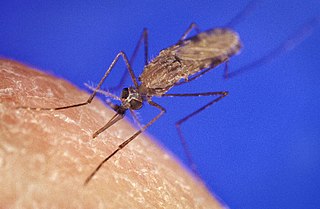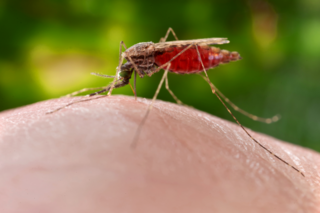
Anopheles is a genus of mosquito first described by J. W. Meigen in 1818, and are known as nail mosquitoes and marsh mosquitoes. Many such mosquitoes are vectors of the parasite Plasmodium, a genus of protozoans that cause malaria in birds, reptiles, and mammals, including people. The Anopheles gambiae mosquito is the best-known species of marsh mosquito that transmits the Plasmodium falciparum, which is a malarial parasite deadly to human beings; no other mosquito genus is a vector of human malaria.
Jan E. Conn is a Canadian geneticist and poet. She resides in Great Barrington, Massachusetts where she does research on mosquito genetics at the Wadsworth Center, Division of Infectious Diseases, New York State Department of Health in Albany, New York. She has also written six books of poetry.

Adolfo Lutz was a Brazilian physician, father of tropical medicine and medical zoology in Brazil, and a pioneer epidemiologist and researcher in infectious diseases.

The Anopheles gambiae complex consists of at least seven morphologically indistinguishable species of mosquitoes in the genus Anopheles. The complex was recognised in the 1960s and includes the most important vectors of malaria in sub-Saharan Africa, particularly of the most dangerous malaria parasite, Plasmodium falciparum. It is one of the most efficient malaria vectors known. The An. gambiae mosquito additionally transmits Wuchereria bancrofti which causes lymphatic filariasis, a symptom of which is elephantiasis.

Anopheles culicifacies is a mosquito species complex and one of the primary vectors of malaria on the Indian subcontinent. It consists of five sibling species, provisionally designated as species A, B, C, D, and E. It prefers to rest indoors in cattle sheds, where it feeds on cattle. The control of A. culicifacies has become difficult due to the development of insecticide resistance against all commonly used insecticides, including new-generation insecticides such as synthetic pyrethroids.

Anopheles dirus is a vector of malaria in Asian forested zones.

Anopheles quadrimaculatus is a species of mosquito mainly located in Eastern United States, America. The species is a main vector of malaria.

Anopheles stephensi is a primary mosquito vector of malaria in urban India and is included in the same subgenus as Anopheles gambiae, the primary malaria vector in Africa. A. gambiae consists of a complex of morphologically identical species of mosquitoes, along with all other major malaria vectors; however, A. stephensi has not yet been included in any of these complexes. Nevertheless, two races of A. stephensi exist based on differences in egg dimensions and the number of ridges on the eggs; A. s. stephensisensu stricto, the type form, is a competent malaria vector that takes place in urban areas, and A. s. mysorensis, the variety form, exists in rural areas and exhibits considerable zoophilic behaviour, making it a poor malaria vector. However, A. s. mysorensis is a detrimental vector in Iran. An intermediate form also exists in rural communities and peri-urban areas, though its vector status is unknown. About 12% of malaria cases in India are due to A. stephensi.

Anopheles darlingi, the American malaria mosquito, is a species of mosquito in the family Culicidae. A. darlingi is one of the major species of mosquito known to be responsible for malaria in the Amazonian regions. It has a wide range of geographic distribution that stretches from Mexico and Argentina but it has also been found to populate in areas affected by deforestation and environment changes due to humans.

Thorselliaceae is a family of bacteria belonging to the class Gammaproteobacteria and it was first described in February 2015. It is not assigned to an order. The family consists of four species in two genera. The bacteria are Gram-negative and rod shaped, approximately 1 μm wide and 2 μm long. They are facultative anaerobes and motile. Thorselliaceae bacteria have been found around the world associated with vector mosquitoes, mainly with vectors of malaria.
Anopheles nili is a species of mosquito in the Culicidae family. It comprises the following elements: An. carnevalei, An. nili, An. ovengensis and An. somalicus. The scientific name of this species was first published in 1904 by Theobald. It is the main mosquito species found in the south Cameroon forest zone which bites humans. It is known as a problematic carrier of malaria, although newly discovered, closely related species in the same genus have also been found to interact with A. nili as a disease vector. In that, they both have similar feeding habits on local targets in the Cameroon region.
The Walter Reed Biosystematics Unit ("WRBU") is a US Army organization that conducts laboratory and field research on the systematics of medically important arthropods in support of epidemiological investigations and disease prevention and control strategies of importance to the military. Research is carried out worldwide, within geographic or faunistic restrictions of the material available and military requirements. Research efforts focus on the development of accurate and reliable means of identifying vectors of arbopathogens of humans.

Anopheles freeborni, commonly known as the western malaria mosquito, is a species of mosquito in the family Culicidae. It is typically found in the western United States and Canada. Adults are brown to black, with yellow-brown hairs and gray-brown stripes on the thorax. Their scaly wings have four dark spots, which are less distinct in the male.
Anopheles nuneztovari is a species of mosquito in the order Diptera native to South America. The species was named by its discoverer, Arnoldo Gabaldón, to honor the Venezuelan entomologist Manuel Núñez Tovar.

Aedes scapularis is a species of mosquito primarily found in neo-tropical regions of the Americas.
Anopheles cruzii, is the species of mosquito that mainly located in southern coast of Brazil, is main vector of malaria, Plasmodium vivax.

Anopheles maculipennis is a species of mosquito that can be found mostly in Europe and New Zealand. It is one of the main vectors of malaria.

Anopheles merus is a species of mosquito that can be found in coastal areas of Eastern and Southern Africa. The species is a main vector of malaria.

Anopheles quadriannulatus is a species of mosquito that can be found in Sub-Saharan Africa with the exception of West Africa and Madagascar. The species is a vector of malaria.

Anopheles farauti is a species of mosquito that is an important malaria vector occurring in Papua New Guinea, neighbouring islands and Australia. A. farauti is common in coastal areas and breeds in brackish water rich in organic matter. It is often found in coastal swamps and mangrove forests.














